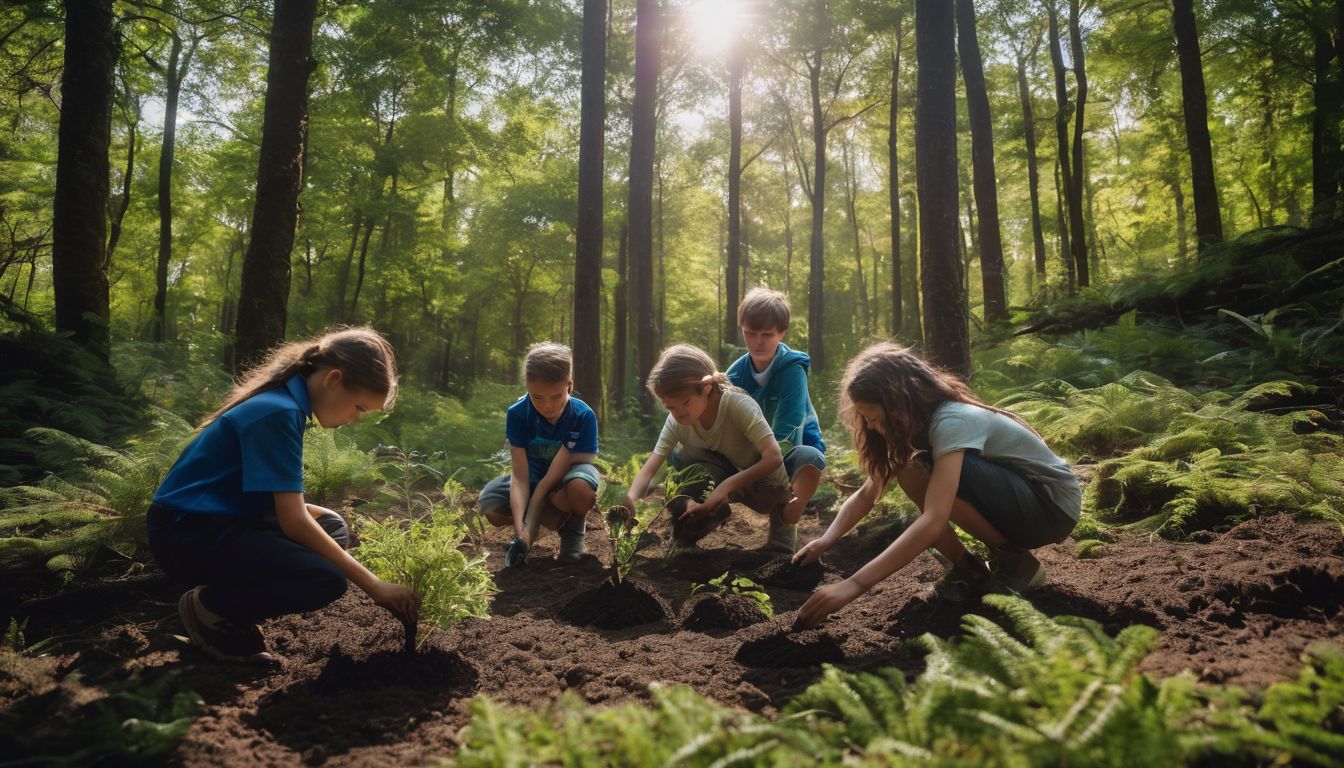As electricity bills soar, many of us seek sustainable ways to power our homes. Wind energy is a force of nature that’s clean and endlessly available. This article will guide you through how harnessing wind can lighten your energy load and benefit the planet.
Let’s catch the breeze!
Key Takeaways
- Wind energy is a renewable source that uses the natural movement of air to produce electricity, with wind turbines turning kinetic energy into mechanical power.
- Technological advancements in turbine design and materials like carbon fiber are making wind power more efficient and reliable.
- Offshore wind projects capture stronger winds over the sea to generate more electricity, while small-scale systems allow individuals and communities to create their own sustainable energy.
- The growth of wind energy has many benefits including significant reductions in greenhouse gas emissions, conservation of water resources, job creation across various sectors, and economic growth for local communities.
- Despite challenges like intermittency and visual impact, innovations such as energy storage systems are improving the viability of wind as a consistent clean energy source.
Understanding Wind Energy
Wind energy is an abundant and renewable resource that harnesses the kinetic energy of the wind to generate electricity. Wind turbines, through their design and dynamics, are able to capture this natural power and convert it into usable energy for homes, businesses, and communities.
Basics and Dynamics
Harnessing wind energy taps into the kinetic energy produced by natural air movements. As winds blow, they carry kinetic energy that can be captured and converted into electricity.
This process begins with the fundamentals of aerodynamics, where blade design plays a crucial role in capturing wind efficiently. Turbine blades are shaped to make the most of every breeze, turning rotational motion into mechanical power.
This mechanical power then drives a generator to produce clean electricity for homes and businesses. The dynamics of wind vary based on location, temperature differences, and terrain among other factors, which directly affects turbine performance.
Engineers study these dynamics intensely to optimise site selection and turbine design for maximum output and sustainability—pioneering green technology to light up our world without harming it.
How Wind Turbines Generate Electricity
Wind turbines generate electricity by harnessing the kinetic energy of the wind. As the wind blows, it causes the turbine’s blades to spin, which in turn rotates a generator inside the turbine.
- The spinning motion of the blades converts the kinetic energy of the wind into mechanical energy.
- This mechanical energy is then transformed into electrical energy through electromagnetic induction within the generator.
- The electricity produced is then transmitted via cables from the turbine to power stations or directly into the electrical grid.
Evolution and History of Wind Energy Technology
Over the years, wind energy technology has evolved significantly. The first recorded use of wind power dates back to ancient civilizations where simple windmills were utilised for tasks like grinding grains and pumping water.
However, it wasn’t until the late 19th century that the modern concept of harnessing wind energy for electricity generation began to take shape with the invention of the first functioning wind turbine by Charles F.
Brush in 1888.
Since then, there have been remarkable advancements in wind energy technology, including more efficient rotor designs, taller towers to capture stronger winds at higher altitudes, and sophisticated control systems to optimise energy production.
These developments have led to a substantial increase in the capacity and overall efficiency of wind turbines, positioning them as a prominent player in today’s global shift towards renewable energy sources.
Benefits and Challenges of Wind Energy
Harnessing the power of wind energy brings numerous benefits, including reducing greenhouse gas emissions and dependence on fossil fuels. However, challenges such as intermittency and visual impact need to be considered for effective deployment of wind power.
Advantages of Wind Power
Wind power offers numerous advantages. It’s a clean, renewable energy source that reduces reliance on fossil fuels and decreases harmful emissions. Harnessing wind energy also helps to mitigate climate change and reduce air pollution.
Moreover, wind power can provide a reliable and cost-effective source of electricity, contributing to energy security and independence from grid power. Additionally, it creates economic opportunities by supporting local job growth in the manufacturing, installation, and maintenance of wind farms.
The benefits extend beyond environmental and economic aspects. Wind power has the potential to enhance community resilience through distributed energy systems, promoting self-sufficiency and reducing dependency on centralised sources of electricity.
Challenges of Wind Power
Wind power faces challenges, including intermittency and variability of wind speeds. This can affect the reliability of electricity generation from wind turbines. Additionally, the visual impact and noise generated by large-scale wind farms can be a concern for local communities.
Another challenge is the initial capital cost for setting up wind energy infrastructure and integrating it into existing electrical grids.
Despite these challenges, technological advancements in energy storage systems and grid management are enhancing the viability of wind power as a reliable source of clean energy. Innovations in turbine design and blade materials are also addressing concerns related to noise levels and visual impact.
Overcoming these challenges will lead to broader acceptance and integration of wind power into our sustainable energy landscape.
Innovations and Future Trends in Wind Energy
Offshore wind energy projects are becoming more popular as technology advancements make it easier to build and maintain turbines in deeper waters. Additionally, small-scale and distributed wind systems are on the rise, providing opportunities for individuals and communities to generate their own renewable energy.
Offshore Wind Energy Projects
- Harnessing Stronger Winds: Offshore locations offer higher and more consistent wind speeds, resulting in increased electricity generation.
- Expanding Energy Potential: They provide opportunities to tap into vast untapped renewable energy resources, meeting growing energy demands sustainably.
- Reducing Visual Impact: Located far from shore, they minimise visual impact on coastal landscapes, addressing concerns about aesthetics.
- Addressing Land Constraints: Offshore locations address land use limitations associated with onshore wind farms, contributing to efficient use of space.
- Challenging Installation: The installation process presents technical challenges due to the need for specialised equipment and expertise in marine construction.
Small-Scale and Distributed Wind Systems
- Localised Power Generation
- Off – Grid Solutions
- Community – Based Initiatives
- Environmental Impact
- Scalability
- Reliability
- Financial Incentives
- Educational Opportunities
Emerging Technologies and Materials
New materials and technologies are continuously being developed to improve the efficiency and reliability of wind energy systems. Advanced composite materials, such as carbon fibre, are increasingly used in turbine blades due to their strength, lightness, and resistance to corrosion.
Additionally, ongoing research is focused on enhancing the performance of turbine components through innovations like advanced control systems and predictive maintenance algorithms.
These advancements aim to optimise energy production while reducing operational costs and environmental impact.
Furthermore, emerging technologies including airborne wind energy systems and innovative blade designs have the potential to revolutionise the industry by addressing challenges related to land use and intermittency.
For instance, airborne turbines harness high-altitude winds using lighter-than-air devices or kite-like structures with tethers that generate electricity when exposed to wind forces.
The Role of Wind Energy in Sustainable Development
Wind energy plays a crucial role in sustainable development by providing environmental benefits, contributing to the economy, and creating job opportunities. Read more about how wind power is shaping a greener future for our planet.
Environmental Benefits
Wind energy offers several environmental benefits, including its capacity to significantly reduce greenhouse gas emissions. By generating electricity from the natural power of the wind, this form of renewable energy minimises the reliance on fossil fuels, thus helping to lower overall air pollution levels and combat climate change.
Additionally, wind power requires much less water for production compared to traditional forms of electricity generation, effectively conserving this precious resource and contributing to better water management in regions where water scarcity is a concern.
Furthermore, as an inexhaustible source of energy that does not involve the extraction of finite resources like coal or natural gas, wind power helps to preserve ecosystems and landscapes while promoting sustainable development.
Moreover, harnessing wind energy can also have positive impacts on wildlife conservation by reducing habitat disruption and decreasing the risk of oil spills or other environmental disasters associated with conventional energy production methods.
Economic Impact
The growth of wind energy has had a significant economic impact, creating jobs and driving investment in local communities. Wind energy projects have provided opportunities for skilled workers in manufacturing, construction, and maintenance.
Additionally, the development of wind farms has spurred economic activity by attracting investments and stimulating ancillary industries such as transportation, logistics, and hospitality.
Furthermore, the expansion of wind energy has contributed to regional economic development through infrastructure improvements and fiscal revenue generation. This trend is likely to continue as the demand for sustainable energy sources grows globally.
As wind technology advances and becomes more cost-effective, it will further enhance its overall economic contribution.
Job Creation
Building on the economic impact, wind energy contributes significantly to job creation. The development and maintenance of wind farms create employment opportunities in various sectors such as manufacturing, construction, and operations.
Additionally, the expansion of this renewable energy sector fosters a demand for skilled workers, driving workforce development and local economic growth. As the industry continues to evolve with new technologies and projects, it presents a promising landscape for job seekers looking to contribute to sustainable initiatives while supporting their communities.
The socioeconomic benefits extend beyond individual jobs as wind energy projects stimulate secondary industries and services, further amplifying their positive impact on local economies.
Conclusion
In conclusion, wind energy is a powerful and sustainable resource that holds great potential for the future. Harnessing the power of nature, it offers environmentally conscious individuals an alternative to traditional energy sources.
By investing in wind energy, we can contribute to a greener and more sustainable world for generations to come. With ongoing innovations and advancements in technology, wind energy continues to play a vital role in shaping our sustainable future.
FAQs
1. What exactly is wind energy?
Wind energy is a form of green energy that uses the power of nature to generate electricity from the wind.
2. How does wind energy work as an alternative to traditional power sources?
As an alternative energy source, wind turbines capture the natural movement of air and convert it into electricity, reducing reliance on fossil fuels.
3. Can wind energy be used alongside other renewable energies like solar?
Yes, wind energy can complement solar energy by generating power when there’s enough wind, even during times when there’s little sunlight.
4. Why should we consider using more wind energy?
Using more wind energy helps fight climate change by offering a clean and renewable source of electricity with no harmful emissions.





